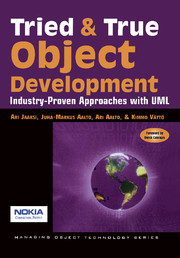Book contents
EPILOGUE
Published online by Cambridge University Press: 06 July 2010
Summary
This book has presented our process model as a collection of phases, notations, models, documents, tips, and rules of thumb. The bigger the development team and the more complicated the system, the more we must place emphasis on how to:
Gather and understand requirements.
Divide the problem and the system into manageable pieces.
Communicate about these pieces.
Make these pieces work together to meet the requirements of our customers.
For gathering and understanding, we use use cases, object analysis, and frequent communication with the customers. For successful management, we use concepts such as system products, application products, applications, components, and classes. These entities divide the problems and the systems into manageable pieces. For communication, we use documents, executable software increments, and face-to-face meetings. The Unified Modeling Language (UML) provides the common notation that can illustrate the different views of problems and systems. Finally, we use frequent builds and incremental software development arranged around prioritized use cases to ensure that we create a beneficial software system in time.
We use many activities and tools during software development that are not included in the process framework. These issues are equally important and they are required to make the use of the process model successful.
Typically, we use a lot of group work and brainstorming during software development projects. For example, we may call a meeting to analyze requirements and use cases, to create analysis class diagrams, to construct preliminary user interface sketches, or to give feedback from a user interface prototype. A process model, though, cannot give much to these sessions.
- Type
- Chapter
- Information
- Tried and True Object DevelopmentIndustry-Proven Approaches with UML, pp. 295 - 298Publisher: Cambridge University PressPrint publication year: 1998

